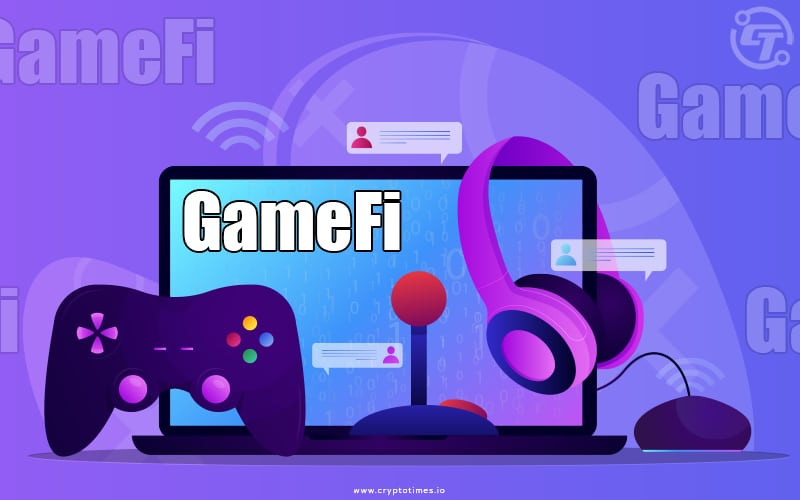
[ad_1]
Crypto Gaming, or GameFi as it’s now more commonly known, has undergone remarkable growth in the last few years. Multiple projects have achieved widespread adoption, thanks to their cross-demographic appeal that’s captured the interest of the global gaming community as well as crypto enthusiasts.
What’s more, this convergence of gaming mechanics with decentralized finance markets has boosted the latter as much as the former: the P2E trend, for instance, has been instrumental in demystifying digital assets and cryptocurrencies, further encouraging mainstream integration.
In a relatively short space of time, the crypto gaming sector has expanded to include everything from NFT play to earn titles to crypto slots. Now, as the year draws to a close, the market is marching on despite fluctuations and the demise of more than one prominent project.
While innovative endeavors are being pursued in other fields, neither the public nor the venture capitalists seem particularly interested in them. Meanwhile, DeFi and GameFi established their economic system within the Web3 realm.
An Introduction to GameFi
If you’re only a casual observer of cryptocurrency trends you may not actually be all that familiar with GameFi. Short for gaming finance, the sector — which is still very much in its burgeoning stage — blends together elements of gaming with decentralized finance (DeFi).
Most of the projects in the crypto gaming space are classed as dApps and their appeal lies in their ability to enhance player experiences with tangible monetization opportunities.
The core idea that underpins the sector is to reward gamers with digital assets (usually in the form of NFTs or native coin tokens) for engaging with games and completing tasks on a play-to-earn (P2E) basis. In addition to being able to earn in-game rewards, the GameFi ecosystem presents players with several other monetization options, including:
- Creating and selling virtual assets including digital real estate
- Trading virtual assets with other players or on decentralized exchanges
- Staking virtual assets to generate passive income streams.
When it comes to the fintech industry, GameFi is quite similar to DeFi in many aspects, but the main distinction is that it takes place entirely inside a game. GameFi includes almost all games with a monetary mechanism. While blockchain and cryptocurrencies are often mentioned in conjunction with GameFi, its history may predate those technologies.
However, if you don’t own it, game publishers won’t let you sell it, and that’s been GameFi’s biggest challenge without blockchain. The markets that have developed to trade virtual goods have historically been both unstable and unreliable. More and more individuals are switching to GameFi, therefore it must be cutting-edge.
Here are the top 10 GameFi projects that you can check out to earn big.
2024’s Most Impactful Crypto Games
Right now, countless projects are populating the GameFi market, all in varying levels of completion. Some have barely reached presale stages, while others hold incumbent positions but will likely need to find ways to evolve in the coming months if they want to keep their strong placements — Axie Infinity, we’re looking at you.
Out of the many crypto games released in last year, a handful have stood out as genuine contenders not just for their potential to offer long-term profits, but also as innovative Web3 experiences that are having a significant impact on the continued integration of the sector into mainstream digital entertainment.
Take Metacade, for example. While most of the projects launched in the space deliver more conventional gaming experiences, Metacade offers up a virtual P2E arcade that gives gamers the freedom to engage with various titles and experiences. The platform has already secured a major collaboration with Polygon, in which new games and NFT initiatives launching on the chain are accessible from the arcade, and has recently added the RPG Sipher Odyssey to its stable.
In addition to Play2Earn, the project will also deliver Compete2Earn and Work2Earn opportunities to users from Q1 2024, further strengthening its position as an innovative Web3 ecosystem.
Bolstering player ecosystems is at the heart of another top GameFi title this year, The Sandbox. This virtual universe is based on a 2D mobile gaming app of the same name first released in 2012, only it has been transformed into a bleeding edge, user-generated open-world game. Ethereum-powered and community-driven, The Sandbox allows users to create and monetize their own gaming experiences and virtual assets.
Harnessing the power of eco-conscious initiatives and sustainability, Chimpzee stands out as a unique crypto-gaming project that empowers both players and organizations to participate in its “green movement”. Gamers can earn crypto rewards by actively safeguarding the natural world under its P2E model, while its Shop2Earn and Trade2Earn models deliver further avenues for income generation that actively support animal welfare and environmental charities.
GameFi is Not All About Rainbows & Unicorns
Sadly, the sector isn’t all success stories. Like most crypto markets, decentralized gaming has had more than its fair share of failures too. In fact, according to data gathered by Coin Gecko, the sector has an average failure rate of 3 out of every 4 projects.
The crypto data aggregator analyzed the performance of 2817 games that launched between 2018 and 2023, and a staggering 2127 of them are now classed as inactive. During 2021, the fail rate of Web3 games levelled at around 45.9%, which then soared to an all-time high following the “crypto winter” of 2022 at 107.1%. Meanwhile, there are around 509 projects that have become inactive in the last year, leaving 2023 with an estimated failure rate of 70.7%.
Although these statistics are unfortunate, they don’t necessarily indicate that GameFi itself is a weak crypto market. In fact, a surge in new entrants is typically a sign of a booming sector, as more startups and entrepreneurs vie for space as trends rise. As the Web3 space itself continues to stabilize, we’ll likely see an even further decline in the failure rate of crypto games.
Closing Thought:
The core of GameFi was captured in the first blockchain games. DeFi and NFTs, however, have changed the game by providing participants with a new way to make serious money.
Developers will continue to combine these ideas to provide more lucrative opportunities for players in the future. It stands to reason that with the type of buzz, GameFi is creating and keeping, more exciting games will be made, which in turn will entice additional investors to the DeFi sector.
[ad_2]


